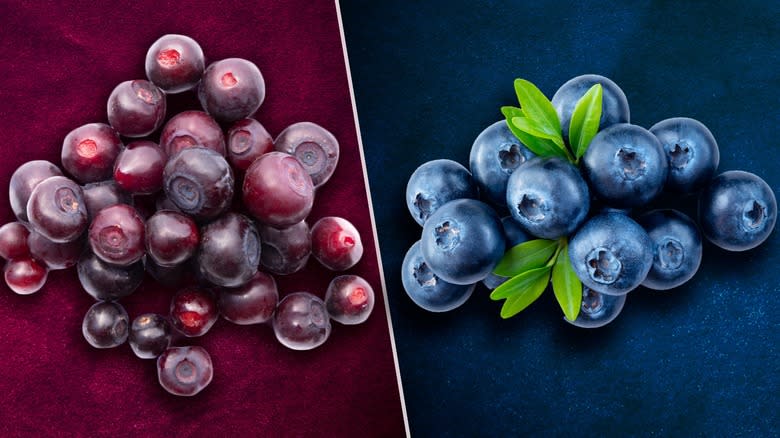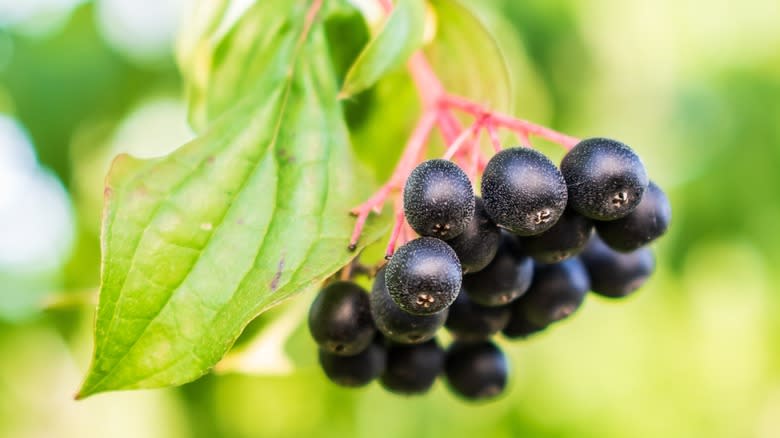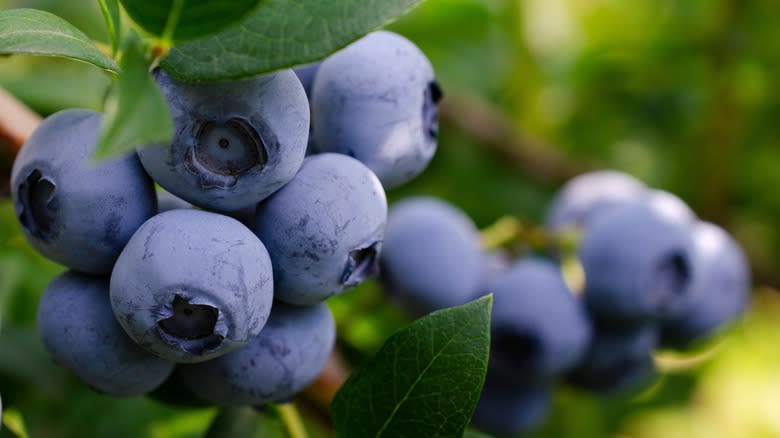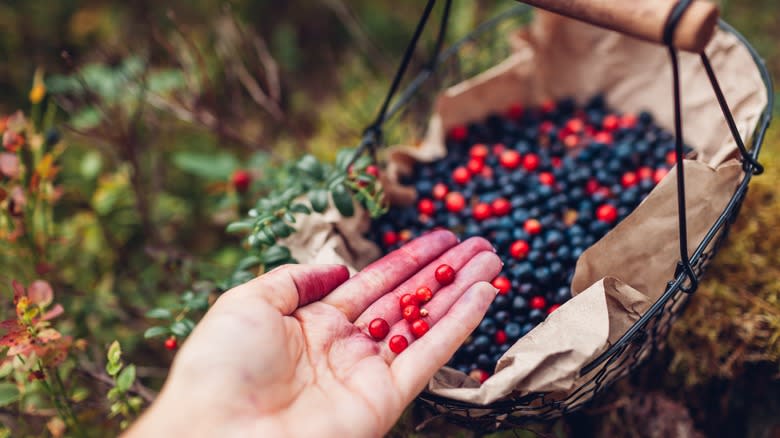What Truly Sets Huckleberries Apart From Blueberries

Among the branches of berry bushes and brambles, two gems stand out among the foliage -- huckleberries and blueberries. At first glance, these tiny fruits may seem remarkably similar, with their juicy appearance and vibrant hues. However, upon closer inspection, it becomes clear that huckleberries and blueberries possess distinct characteristics that set them apart from one another.
Both fruits offer good nutritional qualities, and are high in antioxidants, vitamin C, iron and potassium. And while both huckleberries and blueberries share a similar shape and size, though blueberries tend to be slightly smaller, one notable difference lies in their color. Huckleberries come in two main varieties -- red and blue. In contrast, blueberries are typically a consistent shade of blue except for unripe fruit, which tend to be pale green or white. However, the exterior color is not the only discrepancy in their appearance. Huckleberries and blueberries are also different colors on the inside. To understand these berries better, let's dive into the different varietals more closely. You will likely find that these berries are not as interchangeable as you might think.
Read more: 13 Simple Tricks To Pick The Best Fresh Fruit Every Time
What Are Huckleberries?

Let's start our journey with huckleberries. Belonging to the Vaccinium genus, huckleberries are members of the Ericaceae family, which includes other favorites like cranberries and lingonberries. Huckleberries are native to North America, with species found in regions ranging from the Pacific Northwest to the Rocky Mountains and beyond. Some of the best huckleberries in the United States can be found in northern Idaho thanks to its volcanic soil.
Huckleberries are prized for their intense flavor, which some describe as somewhere between a raspberry and a blueberry. They also have a unique texture, with a slightly chewy skin and small, hard bitter seeds that add crunch to each bite. Red huckleberries are known for their tartness, which pairs beautifully with sweeter dishes like pies and preserves. Blue huckleberries, on the other hand, offer a mellower flavor profile, with a hint of sweetness that makes them perfect for snacking straight from the bush. And once a batch is collected, a huckleberry cobbler makes good use of their fruity flavor. While both have their own uses, it is blue huckleberries that are more similar to blueberries.
What Are Blueberries?

Next up, we have blueberries, which are frequently found in self-pick berry patches and a staple in kitchens. Scientifically known as Vaccinium cyanococcus, blueberries belong to the same genus as huckleberries but are part of the Cyanococcus section within the Vaccinium family. Blueberries are native to North America, with species found throughout the United States and Canada.
Blueberries are prized for their sweet, juicy flesh and rich flavor, which can vary depending on the type and growing conditions. While wild blueberries, which tend to grow on low-branch bushes, have an intense flavor with more sweetness, cultivated blueberries, which grow higher on taller bushes, often have a more mellow flavor. Blueberries are incredibly versatile and can be enjoyed fresh, frozen, or in a variety of culinary applications, from pancakes and muffins to smoothies and salads. Or used to make an ever-popular blueberry pie filling. With many more underrated ways to use blueberries, you can never have too many stashed away in your fridge and freezer.
Huckleberries Come In Two Shades

While huckleberries and blueberries share a similar appearance and growing habitat, the two types of berries differ in color on the inside as well as the outside. While huckleberries can have red or blue skin, these berries tend to have blue or purple flesh on the inside. Blueberries, however, are a light green or even white when split open.
In addition to the differences in their coloration, huckleberries and blueberries also vary in texture. Huckleberries have ten seeds which are noticeably harder than those of blueberries. Blueberries' soft seeds are barely noticeable when eaten, allowing their juicy flesh to take center stage. This is the key factor in blueberries being the more popular fruit.
So, whether you find yourself foraging for wild huckleberries in the mountains or picking plump blueberries at a local farm, take a moment to savor the flavor and appreciate the distinct qualities of these beloved berries. With their vibrant colors, rich flavors, and endless culinary possibilities, huckleberries and blueberries are truly a treasure worth celebrating in every season.
Read the original article on Tasting Table.

